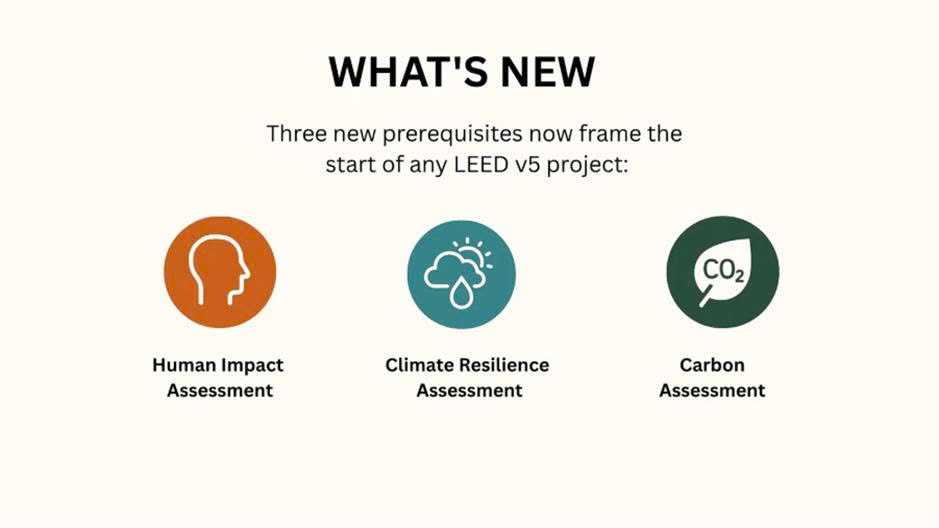
Share:
LEED (Leadership in Energy and Environmental Design) is the world’s leading green building certification system, developed to address environmental challenges while meeting the demands of the construction market. With its latest version – LEED v5, the system sets stricter standards, expanding the evaluation scope from energy efficiency to three pillars: decarbonization, quality of life, and ecosystem conservation & restoration. This article analyzes the core changes of LEED v5, based on scientific foundations and practical applications in sustainable construction.
LEED (Leadership in Energy and Environmental Design) is the world’s leading green building certification system, developed to address environmental challenges while meeting the demands of the construction market. With its latest version – LEED v5, the system sets stricter standards, expanding the evaluation scope from energy efficiency to three pillars: decarbonization, quality of life, and ecosystem conservation & restoration. This article analyzes the core changes of LEED v5, based on scientific foundations and practical applications in sustainable construction.
1. Scientific Basis and Objectives of LEED v5
LEED v5 is designed to:
-
Optimize the use of natural resources.
-
Minimize negative impacts on the environment and human health.
-
Encourage regenerative strategies that enhance living environments.
-
Provide a balanced solution between today’s best practices and forward-looking strategies.
Unlike previous versions, LEED v5 emphasizes whole-building performance rather than isolated solutions, and promotes an integrated, interdisciplinary approach starting from the pre-design phase.
2. Three Core Pillars of LEED v5

2.1 Carbon Assessment
-
The construction industry accounts for about 21% of global GHG emissions (2019).
-
LEED v5 requires a 25-year life-cycle carbon assessment, including energy, refrigerants, embodied carbon, and transportation.
-
Credits such as MRp2, MRc2, MRc4 reinforce carbon calculation and reduction, promoting low-emission materials and long-term mitigation strategies.
2.2 Human Impact Assessment
-
Integrates principles of social equity, public health, and climate resilience.
-
Requires Human Impact Assessment (IPp2) and Climate Resilience Assessment (IPp1), encouraging projects to address both physical and social aspects.
-
Prioritizes occupant health, safety, and well-being through improved indoor air quality, natural daylight, and equitable access.
2.3 Climate Resilience Assessment
-
Requires ecological condition assessments at the pre-design phase (IPc1).
-
Encourages restorative landscape design, responsible material sourcing, and light pollution reduction.
-
Aims to enhance biodiversity, protect natural resources, and build long-term ecological resilience.
3. Integrative Process (IP)
LEED v5 elevates the role of the Integrative Process (IP) category to ensure:
-
Early start: Analysis from pre-design.
-
Right stakeholders: Engagement of community and multidisciplinary experts.
-
Cross-sector collaboration: Finding synergies among building systems.
-
Data-driven evaluation: Understanding risks of climate hazards, carbon emissions, and social impacts.
This approach helps projects not only achieve immediate goals but also establish a foundation for a sustainable, equitable, and resilient future.
4. Key Technical Changes
-
Energy: Stricter modeling standards; emphasis on optimizing envelopes, HVAC, and lighting; expanded requirements for on-site renewables and electrification.
-
Materials: Greater transparency with EPDs, HPDs, and responsible sourcing certifications; design decisions grounded in scientific data.
-
Climate & Resilience: Mandatory integration of adaptation measures such as passive cooling, flood protection, and durable materials.
-
Social Equity: Promotion of workforce diversity, community engagement, and equitable access to green buildings.
-
Indoor Environmental Quality (IEQ): Higher requirements for ventilation, filtration, moisture control, low-VOC materials, and acoustic performance.
5. Conclusion
LEED v5 represents a significant milestone in shaping the future of sustainable construction. By integrating carbon science, quality of life, and ecosystem conservation, LEED not only sets stricter benchmarks but also broadens its scope to social equity and climate resilience.
This evolution not only challenges developers and design teams but also creates opportunities for the global construction industry to move toward a new generation of advanced, equitable, and responsible green buildings—for people and the planet.
Latest news
Special Highlights of COP30: When the World Looks to the Amazon for Climate Action of the Future
COP30 marks the 30th Conference of the Parties to the UNFCCC (United Nations Framework Convention on Climate Change).
Criticality Assessment: The First Step Toward Building Resilience
Europe is entering a major transformation in resilience thinking. Under the Critical Entities Resilience (CER) Directive, organizations are not only required to manage risks but also to understand, demonstrate, and maintain the elements that are “critical” to their operations, economy, and society.
Carbon Trading Systems and the Reshaping of the Construction Industry’s Future
The construction industry is one of the largest sources of greenhouse gas emissions, accounting for around 37% of total global CO₂ emissions (IEA, 2022). The expansion of Emissions Trading Systems (ETS) beyond the energy sector into carbon-intensive industries — including building materials and operational processes — is reshaping the entire cost structure and competitive strategies of the construction sector.
Green Finance in Real Estate: Investment Opportunities and Strategies for Developers in Emerging Markets
The global real estate sector is both the largest source of emissions and the greatest investment opportunity in the journey toward net-zero. According to IFC (2025), greening the construction value chain could unlock USD 1.5 trillion in investment opportunities across emerging markets in the next decade.
LCA and EPD: Scientific Evidence for Transparency in Green Certifications
In today’s global context of increasing focus on sustainability, transparency in data has become a critical requirement in the construction industry. Two prominent tools that address this need are LCA (Life Cycle Assessment) and EPD (Environmental Product Declaration). Beyond helping projects earn credits in green building certification systems such as LEED or BREEAM, LCA and EPD are also long-term strategies to enhance credibility and value for projects.
ARDOR Green is recruiting the next generation of sustainable architects/engineers at the Bach Khoa Career Fair
Founded in 2005, ARDOR Architects has over 20 years of experience in architectural and urban planning consultancy, with participation in more than 150 projects and numerous international awards such as Top 10 Architects Ashui (2017) and BCI Asia Awards (2009, 2015, 2021).
Build Green, Build with ARDOR Green







